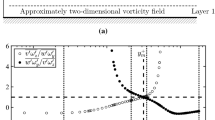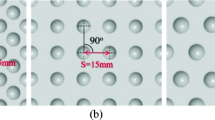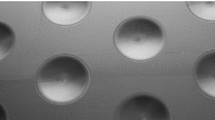Abstract
The effect of a turbulent boundary layer subjected to a series of rounded edged shallow dimple arrays with dimple depth ratios, d/D of 4%, 8% and 12% were experimentally studied. Measurements show the existence of a higher flow speed region at the center of each dimple. The spanwise distribution of the mean wall shear stress immediately downstream of the centers of the last row of dimples does not vary with dimple depth, and is about 45% over that without the dimple array. Turbulence measurements and surface flow visualization shows that the flow over the shallowest dimple differs from the deeper dimples. Flow separation observed with the deeper rounded edged dimples produce similar flow structures as those from sharp edged dimples reported in the literature. However flow separation is not observed when d/D=4% but instead two other higher speed regions either side accompany the central flow. The effects of the dimples are rapidly suppressed by the flat surfaces between of the dimples, and the flow rapidly reverts back to an unmanipulated flat boundary layer flow in these areas.
Similar content being viewed by others
References
Bakchinov, A. A., Grek, G. R., Klingmann, B. G. B., and Kozlov, V. V., “Transition experiments in a boundary-layer with embedded streamwise vortices,” Phys. Fluids, 7 (4), 820 (1995).
Ersoy, S., and Walker, J. D. a., “Viscous flow induced by counter-rotating vortices”, Phys. Fluids 28 (9), 2687–2698 (1985).
Isaev, S. A., Leontiev A. I., and Baranov P. A., “Identification of self organized vortex-like structures in numerically simulated turbulent flow of a viscous incompressible liquid streaming around a dimple on a plane. Technical Phys. Lett., 26, 15–18 (2000).
Isaev, S. A., Leontiev A. I., Kudryavtsev N. A., Pyshnyi I. A., “The Effect of Rearrangement of the Vortex Structure on Heat Transfer under Condition of Increasing Depth of a Spherical Dimple on the Wall of a Narrow Channel,” High Temperature, 41, N2, 229–232. (2003)
Ligrani, P. M., “Flow visualization and flow tracking as applied to turbine components in gas turbine engines,” Measurement Science and Technology 11, 992–1006 (2000).
Ligrani, P. M., Harrison, J. L., Mahmood, G. I., and Hill, M. L., “Flow structure due to dimple depression on a channel surface,” Phys. Fluids 13 (11), 3442–3451 (2001).
Ligrani, P. M., Burgess, N. K., and Won, S. Y., “Nusselt numbers and flow structure on and above a shallow dimpled surface within a channel including effects of inlet turbulence intensity level,” J. Turbomachinery, 127, 321–329 (2005).
Mahmood, G. I., and Ligrani, P. M., “Heat transfer in a dimpled channel: combined influences of aspect ratio, temperature ratio, Reynolds number, and flow structure,” Int. J. Heat and Mass Transfer 45, 2011–2020 (2002).
Mitsudharmadi, H., Winoto, S. H., and Shah, D. A., “Development of most amplified wavelength Görtler vortices”, Phys. Fluids, 18, 014101 (2006).
Neuendorf, R., and Wygnanski, I., “On a turbulent jet flowing over a circular cylinder,” J. Fluid Mech. 381, 1–25 (1999).
Won, S.Y., Zhang, Q., and Ligrani, P. M., “Comparisons of flow structure above dimpled surfaces with different dimple depths in a channel,” Phys. Fluids 17, 045105 (2005).
Yamagishi, Y., and Oki, M., “Numerical simulation of flow around a circular cylinder with curved sectional grooves,” Journal of Visualization 10 (2), 179–186 (2007).
Author information
Authors and Affiliations
Corresponding author
Additional information
Hatsari Mitsudharmadi: He obtained his MEng and Ph.D degree in Mechanical Engineering from the National University of Singapore with the specialisation in Fluid Dynamics/Aerodynamics. Currently he is working as a Research Scientist at Temasek Laboratories, NUS. His research interests are fluid dynamics/aerodynamics and hot-wire anemometry.
Tay Chien Ming Jonathan: He obtained his MEng degree in Mechanical Engineering from the National University of Singapore. Subsequently he joined Temasek Laboratories where he carried out defense related research in experimental fluid dynamics. He has recently transferred and is currently working in the Department of Mechanical Engineering in NUS. His research interests include turbulent flows, aircraft aerodynamics and hot wire anemometry.
Tsai Her Mann: He received his B Sc in aeronautical engineering in 1978 from Imperial College of Science & Technology, London. Upon graduation, he did his PhD in the same college in experimental fluid mechanics. He has conducted research in Queen Mary College, London in direct and large eddy numerical simulation of turbulent flows. He has worked for the DSO National Laboratories, Singapore, where he researched and developed major codes for flow analysis and conducted studies in applied aerodynamics. Subsequently he joined Temasek Laboratories, National University of Singapore, where he started university based defense related aeronautics research work in a range of aeronautical problems from experimental flow control to flow computations and analysis for design and optimization of aerodynamic devices. To date Dr Tsai has published over 110 articles and co-edited a book on flow control.
Rights and permissions
About this article
Cite this article
Mitsudharmadi, H., Tay, C.M.J. & Tsai, H.M. Effect of rounded edged dimple arrays on the boundary layer development. J Vis 12, 17–25 (2009). https://doi.org/10.1007/BF03181939
Received:
Accepted:
Issue Date:
DOI: https://doi.org/10.1007/BF03181939




